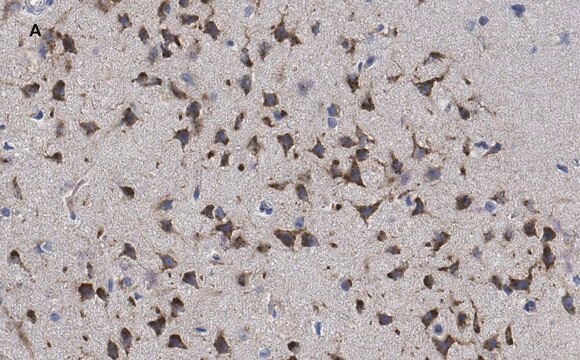04-823
Anti-phospho-GluR1 (Ser831) Antibody, clone N453, rabbit monoclonal
culture supernatant, clone N453, Upstate®
Synonym(s):
AMPA 1, AMPA-selective glutamate receptor 1, Glutamate receptor ionotropic, AMPA 1, glutamate receptor, ionotropic, AMPA 1
Sign Into View Organizational & Contract Pricing
All Photos(1)
About This Item
UNSPSC Code:
12352203
eCl@ss:
32160702
NACRES:
NA.41
Pricing and availability is not currently available.
Recommended Products
General description
L glutamate is the major excitatory neurotransmitter in the central nervous system. Glutamatergic neurotransmission is involved in most aspects of normal brain function and can be perturbed in many neuropathologic conditions. The metabotropic glutamate receptors are a family of G protein coupled receptors that have been divided into 3 groups. Group I includes GRM1 and these receptors have been shown to activate phospholipase C. GRM1 expression has been reported in various regions of the brain and spinal cord. ESTs have been isolated from brain and eye libraries.
Specificity
Predicted cross-reactivity with human, mouse and chicken
Recognizes GluR1 phosphorylated on Serine 831.
Immunogen
KLH-conjugated, synthetic peptide containing the sequence ...QQ[pS]IN… in which pS corresponds to phospho-serine at position 831 of the GluR1 mature chain. Sequence is identical in human, rat, mouse and chicken.
Application
Western Blot Analysis:
A 1:1,000-1:4,000 dilution of this lot detected phosphorylated GluR1 from a rat brain microsomal preparation (Catalog # 12-144).
A 1:1,000-1:4,000 dilution of this lot detected phosphorylated GluR1 from a rat brain microsomal preparation (Catalog # 12-144).
Anti-phospho-GluR1 (Ser831) Antibody, clone N453 detects level of phospho-GluR1 (Ser831) & has been published & validated for use in WB.
Research Category
Neuroscience
Neuroscience
Research Sub Category
Neurotransmitters & Receptors
Neurotransmitters & Receptors
Quality
routinely evaluated by western blot
Target description
106 kDa
Linkage
Replaces: 05-823
Physical form
Cultured supernantant in 0.05% sodium azide.
Storage and Stability
Stable for 1 year at -20°C from date of receipt.
For maximum recovery of product, centrifuge the vial prior to removing the cap.
For maximum recovery of product, centrifuge the vial prior to removing the cap.
Analysis Note
Control
Rat brain
Rat brain
Legal Information
UPSTATE is a registered trademark of Merck KGaA, Darmstadt, Germany
Disclaimer
Unless otherwise stated in our catalog or other company documentation accompanying the product(s), our products are intended for research use only and are not to be used for any other purpose, which includes but is not limited to, unauthorized commercial uses, in vitro diagnostic uses, ex vivo or in vivo therapeutic uses or any type of consumption or application to humans or animals.
Not finding the right product?
Try our Product Selector Tool.
recommended
Storage Class Code
12 - Non Combustible Liquids
WGK
WGK 1
Flash Point(F)
Not applicable
Flash Point(C)
Not applicable
Certificates of Analysis (COA)
Search for Certificates of Analysis (COA) by entering the products Lot/Batch Number. Lot and Batch Numbers can be found on a product’s label following the words ‘Lot’ or ‘Batch’.
Already Own This Product?
Find documentation for the products that you have recently purchased in the Document Library.
Ji-Chao Ma et al.
Cellular physiology and biochemistry : international journal of experimental cellular physiology, biochemistry, and pharmacology, 50(4), 1601-1616 (2018-10-26)
It has been reported that myocardial infarction (MI) is a risk factor for vascular dementia. However, the molecular mechanism remains largely unknown. MI mice were generated by ligation of the left coronary artery (LCA) for 4 weeks. Passive and active
A Barria et al.
The Journal of biological chemistry, 272(52), 32727-32730 (1998-01-31)
Ca2+/CaM-dependent protein kinase II (CaM-KII) can phosphorylate and potentiate responses of alpha-amino3-hydroxyl-5-methyl-4-isoxazole-propionate-type glutamate receptors in a number of systems, and recent studies implicate this mechanism in long term potentiation, a cellular model of learning and memory. In this study we
M Adrienne McGinn et al.
Alcoholism, clinical and experimental research, 40(12), 2537-2547 (2016-11-01)
Nicotine use increases alcohol drinking, suggesting that the combination of these drugs may produce synergistic effects in activating reward circuitry. Alternatively, use of either of these drugs may facilitate the development of cross-tolerance to the other to promote intake escalation.
Frank J Meye et al.
Nature neuroscience, 18(3), 376-378 (2015-02-03)
Addictive substances mediate positive and negative states promoting persistent drug use. However, substrates for aversive effects of drugs remain elusive. We found that, in mouse lateral habenula (LHb) neurons targeting the rostromedial tegmental nucleus, cocaine enhanced glutamatergic transmission, reduced K(+)
K W Roche et al.
Neuron, 16(6), 1179-1188 (1996-06-01)
We have characterized the phosphorylation of the glutamate receptor subunit GluR1, using biochemical and electrophysiological techniques. GluR1 is phosphorylated on multiple sites that are all located on the C-terminus of the protein. Cyclic AMP-dependent protein kinase specifically phosphorylates SER-845 of
Our team of scientists has experience in all areas of research including Life Science, Material Science, Chemical Synthesis, Chromatography, Analytical and many others.
Contact Technical Service








